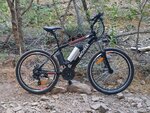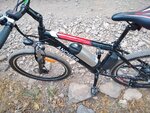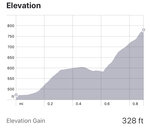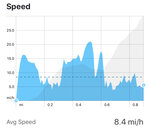EbikeTestLab
Member
Court sent me an Ancheer Ebike for testing that Mikey had reviewed prior, thanks Court and Mikey! Not surprisingly, it failed during testing...
Here's the data, with a failure summary toward the end:
For all of EBTL’s testing of the Ancheer, the rider and instrumentation equal a total weight of 200 pounds, as is standard for EBTL's tests. The weather was 76 to 80 degrees F and the wind speed was near zero (early mornings are the best time to test).
Brake testing is probably the most important factor, at least when it comes to safety. With the higher speeds that ebikes can achieve, braking becomes critical. And with the advent of ABS systems for ebikes, manufacturers are catching on to the importance of good brakes. This test appears very simple, achieve the desired speed, then simply stop as quickly as you can. For the Ancheer, this means pulling the front lever as hard as possible as it wouldn’t lock the front wheel, nor would it lift the rear wheel. The rear brake is engaged fully as well, which resulted in skidding. It takes practice to get it right! And every ebike rider should practice emergency stopping from top speed on different road conditions when and where they can safely do so.
The Ancheer stopped at an average distance of 33.2 feet from 20 mph. After each full stop, severe brake fade was noticed with the fifth and sixth stops requiring much longer distances as the front brake simply wasn’t applying as much pressure to the rotor. The first stop was completed in 30.9 feet and the last required 36.8 feet from 20 mph. Brake fade can happen to any brake as the friction surface becomes too hot to remain as effective as when cold. Better friction materials can prevent this. However, in real world use, it's unlikely that one would need to use the brakes repeatedly enough to notice brake fade except for perhaps, after braking going down a long hill.
For the road load range evaluation, the bike is simply pedaled with zero assist at 5, 10, 15, and 20 . The power required to move the bike at each speed is then determined and an equation is developed to represent that relationship. The Ancheer Mountain Bike results are below:

Once this is determined, one can calculate the power required to maintain the speed of each PAS setting:
Ancheer Road Load vs. Speed
Once the power required is known, the range in miles for each PAS and rider input can be calculated, results for the Ancheer below assuming 100% of the battery is used:
This road load range should differ from the real-world range as it assumes a constant steady state speed over level ground with no coasting. In real world usage, many variables can affect road load and range.
As an example of how to use the tables: a 200 pound rider who is contributing 100 watts of pedaling can expect to reach 29.9 miles at 17 mph while using maximum assist. To conserve battery life, one should discharge no lower than 20%, which would leave 80% of the battery capacity. In this instance, with only 80% of the battery capacity, the range in the above example would reduce by 20% to 23.9 miles.
The acceleration test is straight forward, how fast does it get from zero to the desired speed?
The Ancheer was slightly slower with zero effort pedaling vs. throttle only. I attribute this to the battery being slightly more discharged as the throttle only testing was completed first. You'll also note that the acceleration to 17 mph is recorded with moderate pedaling effort. The target for this is 150 watts of pedal power, and for this testing, the average was 145.1 watts.
As a comparison, a Faraday Cortland, which also claims a 250 watt geared hub motor achieved 20 mph in 12.5 seconds with 150 watts of pedaling, where the Ancheer achieved 17 mph in roughly the same amount of time.
For the Hill Climb Test, the Ancheer climbed 0.11 miles up the mile long Ice Pond hill using only the throttle before coming to a stop. It's average speed for this portion was 9.9 mph. Essentially, the ebike stopped as soon as the hill began to start.
For the 100 watts of pedaling portion, the assist was set to “High”. Only 0.27 miles of the hill were completed before more than 150 watts of pedal power was needed to continue climbing. Therefore, the test was stopped. The average speed was 6.2 mph with an average rider input of 101 watts. This was the first ebike tested that wouldn’t climb the complete hill with 100 watts of rider input. The Faraday Cortland tested previously, which also claims a 250 watt hub motor, climbed the entire hill with an average rider input of 104 watts with an average speed of 7.2 mph. These results would indicate that the Ancheer is putting down less power than the Faraday.
After coasting back down, the decision was made to simply pedal as much as necessary with the assist set to “High” to see how much rider power was needed to complete the mile long Ice Pond Hill. With an average rider input of 186 watts and a max of 430 watts, the Ancheer Mountain Bike completed the 1 mile hill climb in 6:55, with an average speed of 8.5 mph.
However, with only 10 feet or so left to the crest, the motor stopped assisting. Both the motor and controller housing were very hot. After allowing for the ebike to cool off, the motor would not apply power, or even make any noise, with throttle or pedal assist. After some diagnosis, it appears the motor controller had failed as there is no DC voltage going to the hall sensors. The motor tests okay with a digital multimeter but it too may be damaged. Update as of January 2020 (sorry for the delay): The controller had failed. A direct replacement for the controller couldn't be located but we were able to test the motor with a similar controller and it works fine.
Unfortunately, due to the breakdown of the ebike during the hill climb test, a real-world range test could not be completed.
Here's the data, with a failure summary toward the end:
Electric Bike Test Lab Test Report of:
Ancheer Mountain Bike (Model AN-EB001)
Tested in August of 2019 by
Jason Holmes (Chief Engineer and Owner)
Summary of Test Results


Ancheer Mountain Bike (Model AN-EB001)
Tested in August of 2019 by
Jason Holmes (Chief Engineer and Owner)
Summary of Test Results


- Braking Distance from 20 mph: 33.2 feet
- Brake Fade: Severe
- Real World Range on Highest PAS (High): N/A
- Max Speed Throttle Only: 17 mph (non-adjustable)
- Zero to 5 mph Throttle Only: 2.7 seconds
- Zero to 17 mph Throttle Only: 15.9 seconds
- Max Assisted Speed: 17 mph (non-adjustable)
- Zero to 17 mph with zero effort spinning: 16.2 seconds
- Zero to 17 mph with moderate pedaling: 12.3 seconds
- Throttle only hill climb: 0.17 miles before stopping at 1:00 (average speed of 9.9 mph)
- 100 Watts of pedaling hill climb: 0.27 miles before stopping at 2:36, average speed of 6.2 mph, average pedal power of 101 watts.
- Complete hill climb: One mile long hill completed in 6:55, average speed of 8.5 mph, average pedal power of 186 watts. NOTE: The motor stopped just short of the crest – ebike inoperable after that. Failure determined to be motor controller, most likely due to overheating. Read below for more.
Ebike Specs of Note
- Motor type: Rear wheel mounted geared hub
- Rated power: 250 watts
- Battery Details: 36 volts, 8.0 amp-hour = 288 watt-hours
- Claimed weight: About 20 kg (44.1 lbs)
- Actual Weight: 47 lbs
- Brakes: Mechanical Discs
- Cadence or Torque: Cadence only
- Mileage at time of test: ~30
General Testing Notes
For all of EBTL’s testing of the Ancheer, the rider and instrumentation equal a total weight of 200 pounds, as is standard for EBTL's tests. The weather was 76 to 80 degrees F and the wind speed was near zero (early mornings are the best time to test).
Brake Testing
Brake testing is probably the most important factor, at least when it comes to safety. With the higher speeds that ebikes can achieve, braking becomes critical. And with the advent of ABS systems for ebikes, manufacturers are catching on to the importance of good brakes. This test appears very simple, achieve the desired speed, then simply stop as quickly as you can. For the Ancheer, this means pulling the front lever as hard as possible as it wouldn’t lock the front wheel, nor would it lift the rear wheel. The rear brake is engaged fully as well, which resulted in skidding. It takes practice to get it right! And every ebike rider should practice emergency stopping from top speed on different road conditions when and where they can safely do so.
The Ancheer stopped at an average distance of 33.2 feet from 20 mph. After each full stop, severe brake fade was noticed with the fifth and sixth stops requiring much longer distances as the front brake simply wasn’t applying as much pressure to the rotor. The first stop was completed in 30.9 feet and the last required 36.8 feet from 20 mph. Brake fade can happen to any brake as the friction surface becomes too hot to remain as effective as when cold. Better friction materials can prevent this. However, in real world use, it's unlikely that one would need to use the brakes repeatedly enough to notice brake fade except for perhaps, after braking going down a long hill.
Road Load Range Evaluation
For the road load range evaluation, the bike is simply pedaled with zero assist at 5, 10, 15, and 20 . The power required to move the bike at each speed is then determined and an equation is developed to represent that relationship. The Ancheer Mountain Bike results are below:
Once this is determined, one can calculate the power required to maintain the speed of each PAS setting:
PAS Setting | Max Assisted Speed | Wheel Power Required (watts) |
Low | 9.0 | 49.3 |
Medium | 13.0 | 116.8 |
High | 17.0 | 213.7 |
Ancheer Road Load vs. Speed
Once the power required is known, the range in miles for each PAS and rider input can be calculated, results for the Ancheer below assuming 100% of the battery is used:
| PAS Setting | Range (zero rider effort) | Range (50 Watts Pedaling) | Range (100 Watts Pedaling) | Range (150 Watts Pedaling) |
| Low | 37.9 | |||
| Medium | 16.0 | 39.2 | ||
| High | 8.7 | 21.3 | 29.9 | 50.6 |
This road load range should differ from the real-world range as it assumes a constant steady state speed over level ground with no coasting. In real world usage, many variables can affect road load and range.
As an example of how to use the tables: a 200 pound rider who is contributing 100 watts of pedaling can expect to reach 29.9 miles at 17 mph while using maximum assist. To conserve battery life, one should discharge no lower than 20%, which would leave 80% of the battery capacity. In this instance, with only 80% of the battery capacity, the range in the above example would reduce by 20% to 23.9 miles.
Acceleration Test Results
The acceleration test is straight forward, how fast does it get from zero to the desired speed?
- Max Speed Throttle Only: 17 mph (non-adjustable)
- Zero to 5 mph Throttle Only: 2.7 seconds
- Zero to 17 mph Throttle Only: 15.9 seconds
- Max Assisted Speed: 17 mph (non-adjustable)
- Zero to 17 mph with zero effort spinning: 16.2 seconds
- Zero to 17 mph with moderate pedaling: 12.3 seconds
The Ancheer was slightly slower with zero effort pedaling vs. throttle only. I attribute this to the battery being slightly more discharged as the throttle only testing was completed first. You'll also note that the acceleration to 17 mph is recorded with moderate pedaling effort. The target for this is 150 watts of pedal power, and for this testing, the average was 145.1 watts.
As a comparison, a Faraday Cortland, which also claims a 250 watt geared hub motor achieved 20 mph in 12.5 seconds with 150 watts of pedaling, where the Ancheer achieved 17 mph in roughly the same amount of time.
Hill Climb Performance
For the Hill Climb Test, the Ancheer climbed 0.11 miles up the mile long Ice Pond hill using only the throttle before coming to a stop. It's average speed for this portion was 9.9 mph. Essentially, the ebike stopped as soon as the hill began to start.
For the 100 watts of pedaling portion, the assist was set to “High”. Only 0.27 miles of the hill were completed before more than 150 watts of pedal power was needed to continue climbing. Therefore, the test was stopped. The average speed was 6.2 mph with an average rider input of 101 watts. This was the first ebike tested that wouldn’t climb the complete hill with 100 watts of rider input. The Faraday Cortland tested previously, which also claims a 250 watt hub motor, climbed the entire hill with an average rider input of 104 watts with an average speed of 7.2 mph. These results would indicate that the Ancheer is putting down less power than the Faraday.
After coasting back down, the decision was made to simply pedal as much as necessary with the assist set to “High” to see how much rider power was needed to complete the mile long Ice Pond Hill. With an average rider input of 186 watts and a max of 430 watts, the Ancheer Mountain Bike completed the 1 mile hill climb in 6:55, with an average speed of 8.5 mph.
However, with only 10 feet or so left to the crest, the motor stopped assisting. Both the motor and controller housing were very hot. After allowing for the ebike to cool off, the motor would not apply power, or even make any noise, with throttle or pedal assist. After some diagnosis, it appears the motor controller had failed as there is no DC voltage going to the hall sensors. The motor tests okay with a digital multimeter but it too may be damaged. Update as of January 2020 (sorry for the delay): The controller had failed. A direct replacement for the controller couldn't be located but we were able to test the motor with a similar controller and it works fine.
Real-World Range Tests
Unfortunately, due to the breakdown of the ebike during the hill climb test, a real-world range test could not be completed.
Last edited:

